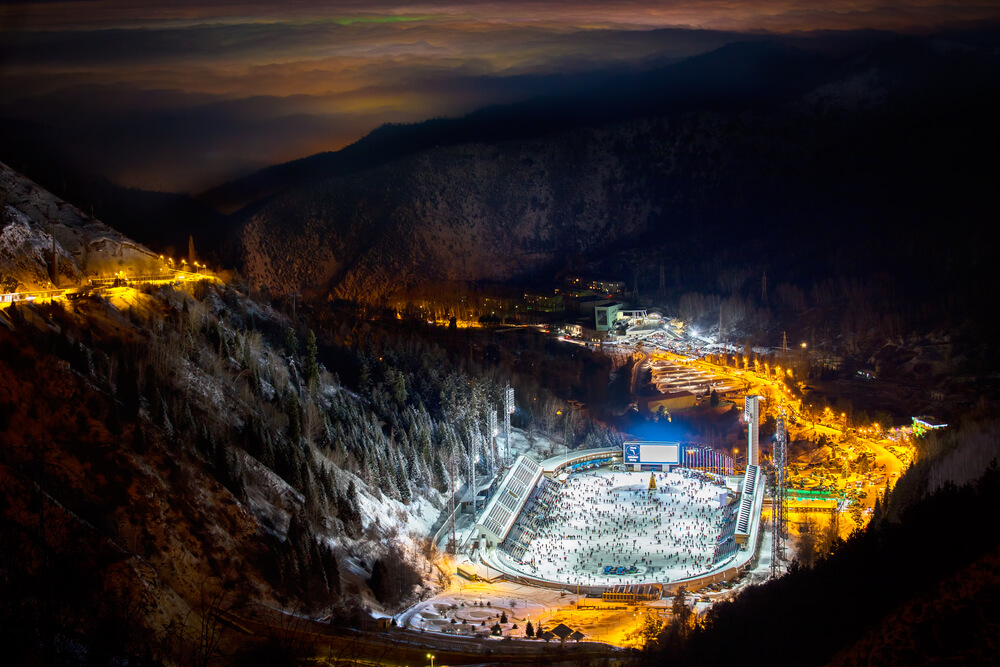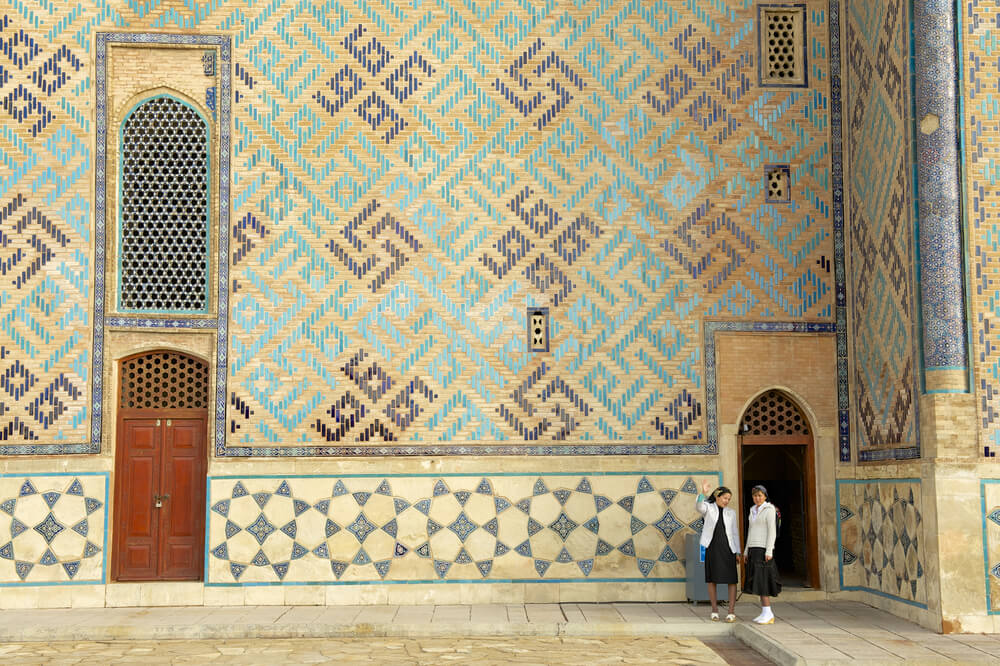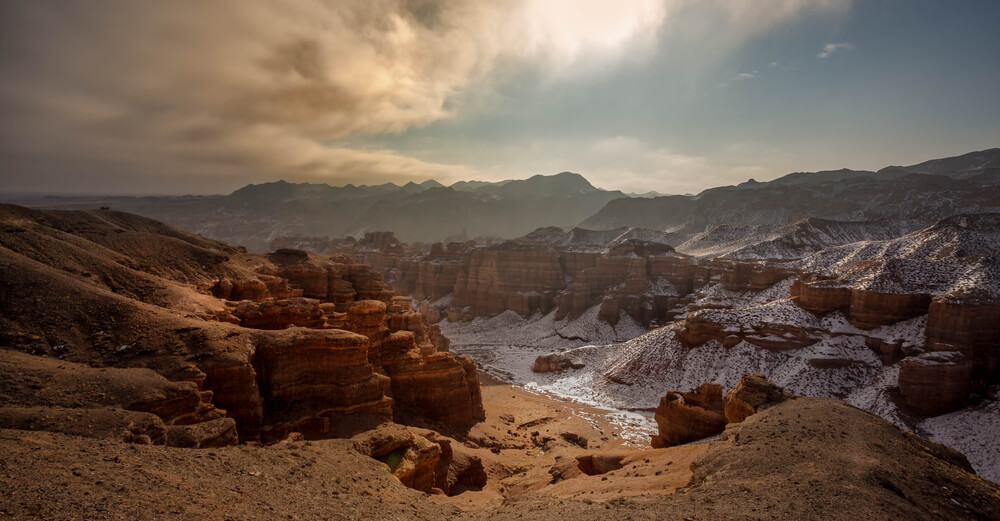NUR-SULTAN, Kazakhstan — There is the Grand Canyon in Arizona. But there is also a grand one, the Charyn Canyon, in Kazakhstan, the vast Central Asian country with curious and wondrous sights that await intrepid tourists.
Sayasat Nurbek, who serves as a National Geographic goodwill ambassador in Kazakhstan, lists the Charyn Canyon, which stretches 56 miles along the Charyn River in the mountainous Southeast, as one of the country’s top sights.
Located near Almaty, Kazakhstan’s former capital, Nurbek describes the canyon as “very futuristic.”
For 12 million years, nature’s sculptors — wind, water and sand — have carved the canyon’s red sandstone to create formations of various shapes and sizes. These have been given names for the fantastic things that they resemble: castles, devils and ghosts.
Nurbek recommends that tourists start their travels in Almaty, the largest city in Kazakhstan with a population of 1.7 million. It is not only the country’s cultural and trading hub, but also the gateway to the region’s natural wonders, including a national park in the Trans-Ile Alatau mountains, which has 300 species of wildlife, including the snow leopard.

Medeu skating rink
Not far from Ile-Alatau National Park, in the Malaya Almatinka Valley, winter tourists can skate on the world’s largest outdoor ice-skating rink, Medeu, and schuss down slopes in Shymbulak, Central Asia’s top skiing resort.
At the Altyn-Emel National Park, also near Almaty, tourists can see the Terekty Petroglyphs and listen to the “singing dunes” — a low, vibrating sound made when the wind moves the sand.
“Almaty is a city where in 15 to 20 minutes, you can get to pristine mountains and lakes —- not like the Swiss or French Alps, where you must travel far from the cities to get to them,” says Nurbek, who has a master’s degree in geopolitics from the Sapienza University of Rome.
Shymkent, the third-largest city in Kazakhstan and an important place along the Great Silk Road, is well worth a stopover, Nurbek says.
“It’s a Southern city with a rich cultural and historical heritage. There is great food there, especially kebabs,” he says. You might even wash down your kebabs with kumis — a beverage made with fermented mare’s milk, popular across Central Asia.
In the Kazakh desert, about 93 miles northwest of Shymkent, lies an ancient center of the caravan trade: Turkestan. “It’s a spiritual capital,” says Nurbek.
The city, previously called Yasi, is known for the Mausoleum of Khoja Ahmed Yasawi, the Sufi philosopher and poet, which was built at the time of Timur (Tamerlane), from 1389 to 1405. The imposing, turquoise-domed mausoleum is partly unfinished, but its Persian master builders experimented with architectural and structural solutions later used in the construction of Samarkand, the capital of the Timurid Empire. UNESCO designated the exquisite mausoleum as a World Heritage Site in 2003.

The medieval mausoleum of Khoja Ahmed Yasavi in Turkistan, Kazakhstan. Photo: Dmitry Chulov / Shutterstock.com
After touring the South, Nurbek suggests going West to the Caspian, which is the largest lake in the world. Aktau, on the shores of the Caspian, is an inviting beach town.
“There is no other lake in the world that has seals or the strange fish that you will find in the Caspian. You can even collect sharks’ teeth on the beaches because it was once part of a larger sea,” he says.
Nurbek, an avowed “environmental enthusiast,” wants oil and gas exploration in the Caspian to be replaced with “massive caviar production. We would have the same revenues from caviar as from oil.”
There has been an increase in the number of oil fields and, consequently, spills. But, Nurbek says, “they are not catastrophic.” And the Caspian’s prized sturgeon population is growing due to more university-conducted research on the diseases affecting them, he claims.
As for the nascent environmental movement and green party in Kazakhstan, he wishes there were “more people pushing for the environment, more politicians too.”
From the Caspian, Nurbek says tourists should head to the capital city of Nur-Sultan, formerly Astana, in the north-central steppe. The capital was renamed in March to honor President Nursultan Nazarbayev, who abruptly resigned on March 19 after three decades in power.
Nazarbayev moved the capital from Almaty to Astana in 1997. He transformed it from a provincial town to the playground for the world’s leading architects, including Japan’s Kisho Kurokawa, who drew up the master plan for Astana, and Britain’s Norman Foster, who designed the glimmering glass Khan Shatyr shopping mall — the largest tent in the world — which has an indoor beach.
Kazakhstan is the world’s largest landlocked country and its ninth-largest country, about the size of Western Europe. Nurbek recommends that tourists take the country’s trains — a tradition from Soviet times.
“If you are out to experience the vastness of the country — the steppes, the mountains, the lakes — then take the train from Nur-Sultan,” he says, “You can make friends on it, share food, share stories, stop at the stations. You can make memories that will last forever.

 Follow
Follow
Leave a Reply